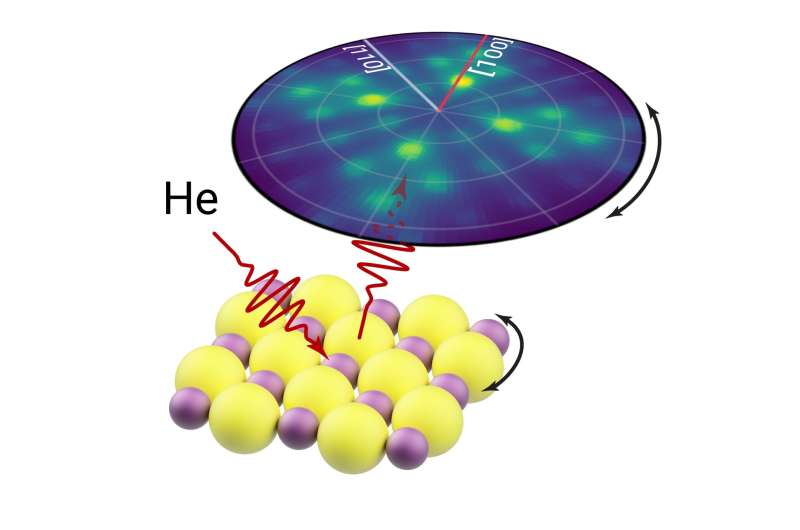January 16, 2024 feature
This article has been reviewed according to Science X's editorial process and policies. Editors have highlighted the following attributes while ensuring the content's credibility:
fact-checked
peer-reviewed publication
trusted source
proofread
Collecting helium diffraction patterns in microscopic regions of samples

Recent scientific advancements have opened new opportunities for the close observation of physical phenomena. Researchers at University of Cambridge and University of Newcastle recently introduced a new method to measure helium atom diffraction with microscopic spatial resolution.
This method, outlined in a paper in Physical Review Letters, allows physicists to study electron-sensitive materials and better understand their morphology using helium microdiffraction.
"The scanning helium microscope has been developed across several research groups for over a decade with a focus on improving the resolution of the instrument and studying technological and biological samples," Matthew Bergin, co-author of the paper, told Phys.org. "However, relatively little work had been done on using the matter wave aspect of the helium beam to study ordered surfaces with a scanning helium microscope."
The recent study by Bergin and his colleagues builds on one of their previous papers published in Scientific Reports in 2020. In this previous work, the researchers observed the signature of diffraction from a microscopic spot on a sample, yet they could not directly measure its underlying diffraction pattern.
In their new paper, they set out to continue their work in this area. Their study's underlying objective was to demonstrate that an atom-based matter wave could be used to form a diffraction pattern from spatially resolved regions of a surface.
"Due to the particle–wave duality of atoms, a helium beam directed at a lattice can behave like a wave and diffract from the periodic structure," Bergin said. "Thermal energy helium atoms possess such a low energy (<100meV) that the obtained diffraction pattern is guaranteed to be uniquely sensitive to the surface structure.
"Helium atom scattering is a well-established technique that uses the position and intensity of these diffraction peaks to study a sample surface, however till now these studies have been restricted to homogenous crystals that are at least several millimeters in size."
In their experiments, Bergin and his colleagues used a scanning helium microscope that uses a pinhole to collimate a helium beam. With this microscope and a carefully designed strategy, they were able to collect diffraction patterns from a small region (~10um) of a sample, despite using a fixed detector.
"By carefully calibrating the instrument, we can move the sample positioning and rotation stages to vary the outgoing detection angle and sample azimuth while illuminating the same spot," Bergin explained. "The result is that we can build an exclusively surface sensitive diffraction pattern from the small, illuminated area of the sample."
The recent work by this research team demonstrates the feasibility of using atoms to collect a diffraction pattern from a microscopic region on a sample's surface. Their proposed method could be used by other physicists to study diffraction patterns and gather new insight about materials that cannot be precisely examined using conventional atom scattering techniques.
"The spatially resolved capabilities of the instrument combined with the excellent surface sensitivity now allows us to use atom scattering to measure the material properties of small samples with interesting surface features, such as flakes of 2D materials," Bergin added.
"At the University of Cambridge, work has already begun on applying the technique to measure diffraction from flakes of 2D materials. Meanwhile, colleagues at the University of Newcastle are developing a new measurement stage that can directly move the detector to collect diffraction patterns without any complex calibration or manipulation of the sample."
More information: Nick A. von Jeinsen et al, 2D Helium Atom Diffraction from a Microscopic Spot, Physical Review Letters (2023). DOI: 10.1103/PhysRevLett.131.236202
Journal information: Scientific Reports , Physical Review Letters
© 2024 Science X Network



















